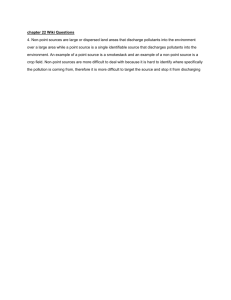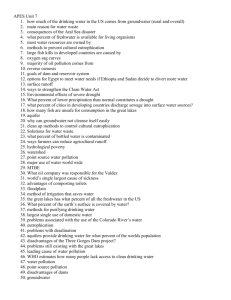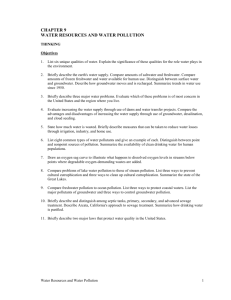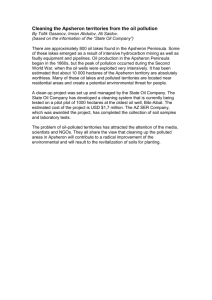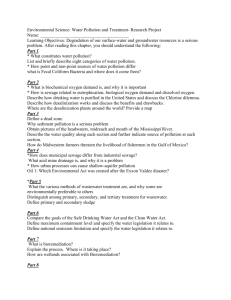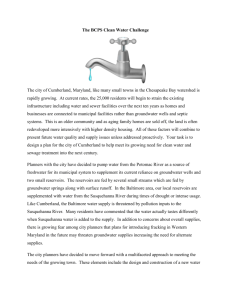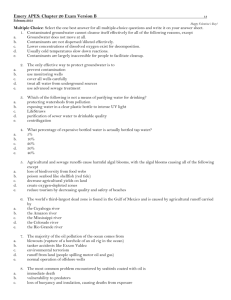APES-Chapter 20-Water Pollution-Study Guide Answer the following
advertisement
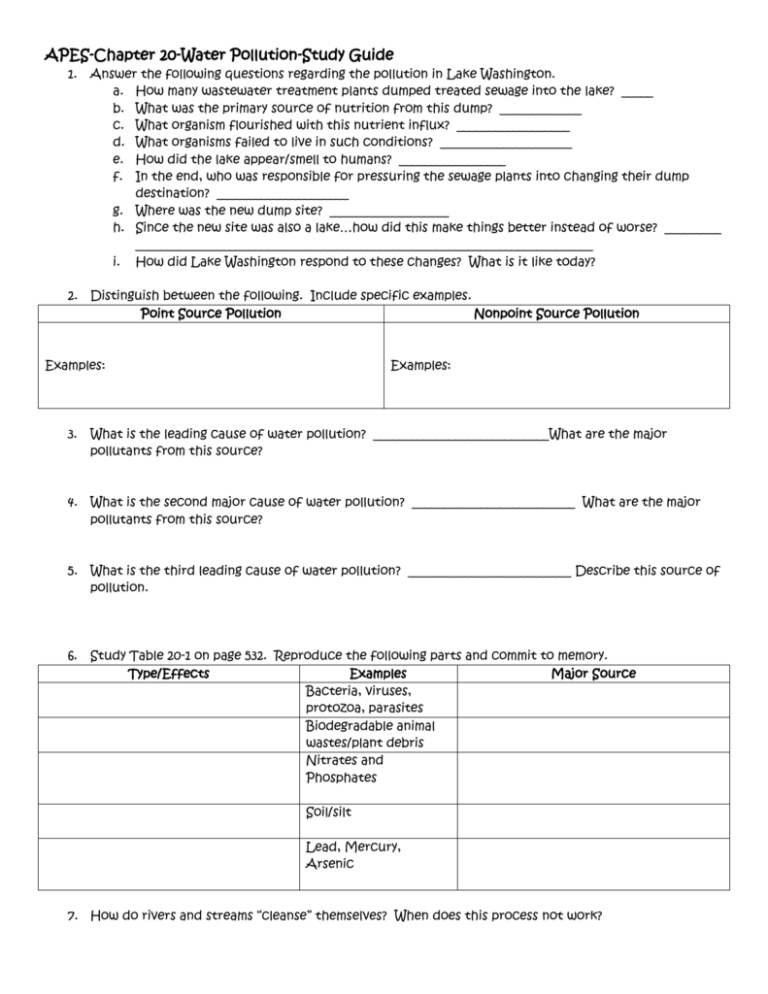
APES-Chapter 20-Water Pollution-Study Guide 1. Answer the following questions regarding the pollution in Lake Washington. a. How many wastewater treatment plants dumped treated sewage into the lake? _____ b. What was the primary source of nutrition from this dump? _____________ c. What organism flourished with this nutrient influx? __________________ d. What organisms failed to live in such conditions? _____________________ e. How did the lake appear/smell to humans? _________________ f. In the end, who was responsible for pressuring the sewage plants into changing their dump destination? _____________________ g. Where was the new dump site? ___________________ h. Since the new site was also a lake…how did this make things better instead of worse? _________ _________________________________________________________________________ i. How did Lake Washington respond to these changes? What is it like today? 2. Distinguish between the following. Include specific examples. Point Source Pollution Nonpoint Source Pollution Examples: Examples: 3. What is the leading cause of water pollution? ____________________________What are the major pollutants from this source? 4. What is the second major cause of water pollution? __________________________ What are the major pollutants from this source? 5. What is the third leading cause of water pollution? __________________________ Describe this source of pollution. 6. Study Table 20-1 on page 532. Reproduce the following parts and commit to memory. Type/Effects Examples Major Source Bacteria, viruses, protozoa, parasites Biodegradable animal wastes/plant debris Nitrates and Phosphates Soil/silt Lead, Mercury, Arsenic 7. How do rivers and streams “cleanse” themselves? When does this process not work? 8. Explain how an oxygen sag curve develops. 9. When the bacteria deplete the dissolved oxygen in an effort to breakdown the biodegradable waste…what happens to the other organisms with high oxygen demands still in the rivers, lakes, or streams? 10. Briefly describe the devastation to the Ohio 11. According to the Global Water Policy Project, most cities in less-developed countries discharge _________ of their _______________ sewage directly into rivers, streams and lakes whose waters are then used for ________________, bathing and washing clothes!!!!! (Makes me want to stay in the US for our TRIP!!!) 12. List two reasons why lakes and reservoirs are generally less effective at diluting pollutants than streams are. As a result, they are more vulnerable to ______________________ by ______________________... 13. Due to the stratified layers and reduced flows in lakes and reservoirs, the concentrations of some harmful chemicals are __________________________________ as they pass through the food web. List 4 examples of such compounds: 14. Compare the following: Eutrophication Oligotrophic Cultural Eutrophication 15. What does a nutrient overload produce? ______________________ reducing the growth of ________ and ________________ which support ____________. 16. Why do the phytoplankton die? 17. What happens to the algae when they die? 18. What happens as a result of the bacterial decomposition of the algae? 19. Besides making the lake smelly…what else can even happen? 20. What was the limiting growth factor for algae blooms? 21. How could we control the amount of phosphates that enter a lake? 22. List 3 ways we can CLEAN UP lakes suffering from cultural eutrophication. 23. What would have been easier? 24. How much of US’s fresh water does the Great Lakes hold? ___________ how much of the world’s freshwater does the Great Lakes hold? __________ How long does it take to flush pollutants from the Great Lakes out to sea? _________ Are the Great Lakes suffering from pollution? _______ 25. Describe the Great Lakes Water Quality Agreement? Why is this so important? 26. Despite this agreement…what still gets released into the Great Lakes? _____________________ 27. Why is it true that groundwater cannot cleanse itself very well. 28. How does groundwater get contaminated with nitrate ions? Is this bad? Why? 29. How does groundwater get contaminated with arsenic? Is this bad? Why? 30. How can groundwater be cleaned up? List and describe three methods. 31. Describe the Safe Drinking Water Act. (you will need to go to the index to get this description) 32. Why should we not buy bottled drinking water? List at least 3 reasons. 33. What portions of the ocean are most severely affected by ocean water pollution? 34. How are they becoming polluted? 35. Why do open ocean waters seem to be less affected by raw sewage dumpage? 36. How do nitrates and phosphates get into the ocean? What does this cause? 37. What is a dead zone…how are they produced? 38. Specifically…describe how oxygen-depleted zones form? What causes it? 39. How can we best deal with water pollution? 40. Describe the Clean Water Act. 41. Outline the Sewage Treatment Process: a. Primary Sewage Treatment: b. Secondary Sewage Treatment: c. Tertiary Sewage Treatment d. Bleaching/Disinfection 42. What does it mean to “treat sewage by working with nature”? 43. List several Solutions to Water Pollution?
